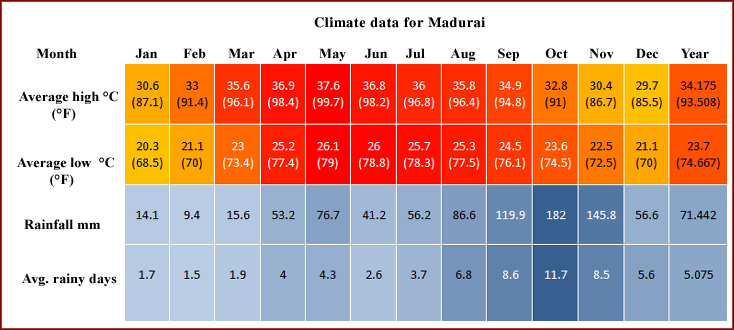Madurai Luxury Travel Information
Madurai Description:
Madurai is the second largest city in Tamil Nadu, the southernmost state of India. The city is over 2,500 years old and is considered the cultural heartland of Tamil society. There is a popular axiom with Tamils that states “Chennai is the heart of Tamil Nadu while Madurai is its soul”.
Madurai has a rich history of cultural development and the city has figured majorly in the rise of various south Indian political orders including Dravidian, Islamic and British Colonial. Even today, Madurai is one of the most important industrial centers in Tamil Nadu as well as a cultural hub that is the seat of the Tamil literary and poet’s societies. The Tamil language is said to be spoken in its purest form in the city.
Anyone touring Madurai will be awe-struck by the city’s signature attractions. The principal attraction of Madurai is the massive Sri Meenakshi Amman Temple Complex. Spread over 6 hectares, the Sri Meenakshi Amman Temple Complex in Madurai is one of the largest temple complexes in South India and was one of the top 30 contenders for the “New Wonders of the World” list. The Temple complex is home to a staggering 33,000 sculptures that are painstakingly detailed in their richness and finesse. The sculptures depict the many deities and their stories straight from the holy scriptures of the Hindu faith.
Another highlight of any tour of the Sri Meenakshi Amman Temple Complex in Madurai is seeing the complex’s gigantic Gopurams. The Gopurams are huge gateway towers. The Sri Meenakshi Amman Temple Complex in Madurai has 14 tall Gopurams. The tallest of these juts 170 feet into the sky above the complex. Each of the Gopurams in the Sri Meenakshi Amman Temple Complex in Madurai is covered with intricate carvings that are colorfully painted, depicting the various religious and mythological characters from Hindu annals.
The Sri Meenakshi Amman Temple Complex in Madurai is dedicated to the worship of the Goddess Paravati (Meenakshi) and her consort Lord Shiva (Sundareswarar). While the present temple complex at the site is around 400 years old and was built during the era of the Nayak rulers of Madurai, the original temple built here is reported to be over 2,000 years old. The predecessor to the present grandiose Sri Meenakshi Amman Temple Complex was said to be equally grand and was destroyed by invaders from North India.
A must-see part of any tour of the Sri Meenakshi Amman Temple Complex in Madurai is viewing the “Hall of One Thousand Pillars” within the temple. The hall, as the name suggests, has one thousand pillars, each of which is placed at an equal distance from one another in a precision laid grid. Each pillar has been individually carved with the same painstaking detail as the fine carvings on the temple exteriors and Gopurams.
The Sri Meenakshi Amman Temple Complex in Madurai is always a beehive of activity with pilgrims coming in and out of the complex. There are always a number of prayer and religious services that are being conducted in the complex, some of which are out of bounds for non-Hindus visitors. Particularly popular activities with visiting tourists at the Sri Meenakshi Amman Temple Complex are the dance performances that are held every weekend at the temple as well as the daily evening prayer service.
Other attractions in the city of Madurai include the Gandhi Memorial Museum. The museum is dedicated to India’s freedom struggle and has some great exhibits highlighting India’s march to freedom. Another point of interest nearby is the Madurai Government Museum that focuses on the pre-historic aspect of the city of Madurai and has great displays of the rock carvings, bronze statues as well as costumes and paintings that have been unearthed at various times during excavations in the Madurai region.
Another iconic monument in Madurai that is very famous with foreign visitors is the Thirumalai Nayak Palace. The Thirumalai Nayak Palace was the former opulent residence of the Nayak Kings of the Madurai region and is a great example of the confluence of Dravidian, Islamic and European architectural influences. The Thirumalai Nayak Palace was built in the year 1636 and was designed by an Italian architect. The palace was commissioned by King Thirumalai Nayak and was counted amongst one of the most regal palaces in all of southern India.
In near proximity to the Sri Meenakshi Amman Temple Complex is a major pond called Vandiyur Mariamman Teppakulam. The Pond is the ancient water supply of Madurai and is connected to the city by an ingenious network of underground channels. The pond itself is as large as the Sri Meenakshi Amman Temple Complex and has a temple and prayer hall on the premises.
Best Time to Visit Madurai:
Madurai has a tropical weather that is typical of South India and Tamil Nadu. Since Tamil Nadu state is close to the thermal equator, most of its cities do not see significant temperature variance throughout the year.
The northeastern Monsoon from mid-October to mid-December brings the most rains to Madurai while for the rest of the year; the city remains hot and humid.
Many people time their tour of Madurai in line with the major festivals that are celebrated in the city. Prominent festivals include the Meenakshi Tirukalyanam Festival that is celebrated in April – May every year and marks the symbolic marriage of the presiding deities of the Sri Meenakshi Amman Temple Complex. The festival is also known as the Chithrai Festival and has over 14 days of special ceremonies and prayers rituals. Another major festival that has been the subject of traveler interest is the Teppana Float Festival that is celebrated in January - February every year.

How to get to Madurai:
Madurai is located in the southern-most Indian state of Tamil Nadu. While Madurai does have a domestic airport providing limited access to larger Indian cities such as Chennai, Kochi, Mumbai and Delhi, it does not provide many convenient connection options.
Most visitors coming to Madurai, tour the city as part of a larger tourist itinerary of South India. This usually involves visiting many other locations of Tamil Nadu including Mahabalipuram, Kanchipuram, Chettinad as well as the Periyar National Park and Backwaters in the neighboring state of Kerala.
Most convenient international gateways to Madurai include the major aviation hubs of Cochin, Chennai or Mumbai that offer convenient international connections to a host of destinations around the world. From here, visitors have multiple options of South India tour itineraries that include stopovers in Madurai and visits to its many attractions.
Madurai Highlights:
Madurai being the heartland of Tamil culture would be of immense interest to enthusiasts of history, culture, mythology, philosophy as well as comparative religion. Also the many attractions of Madurai particularly the Sri Meenakshi Amman Temple Complex are awe-inspiring structures which would be a major draw for anyone interested in photography as well as architecture.
For fans of food and drink, Madurai is an amazing place to sample great Tamil cuisine and authentic Tamil fare such as meals served in banana leaf platters.
Madurai is also a center of excellence for Tamil handcrafts as well as for textiles. The city has a number of famous tailors that can take visitors’ choice of fabric and spin it into any original creation or design that is required at a couple of hours’ notice.
Appropriate Attire:
It is worth remembering that the major attraction at Madurai, the Sri Meenakshi Amman Temple Complex is a functional Hindu temple and a center of pilgrimage for devotees from India and around the world.
The dress code therefore for gaining entry to the temple is very strict. Visiting tourists are required to dress modestly covering arms, legs and shoulders as well as avoid clothing that is too form fitting and revealing. Visitors to the temple will also be required to remove shoes in certain parts and prayer halls so wearing slip-on shoes with socks is a good idea.

